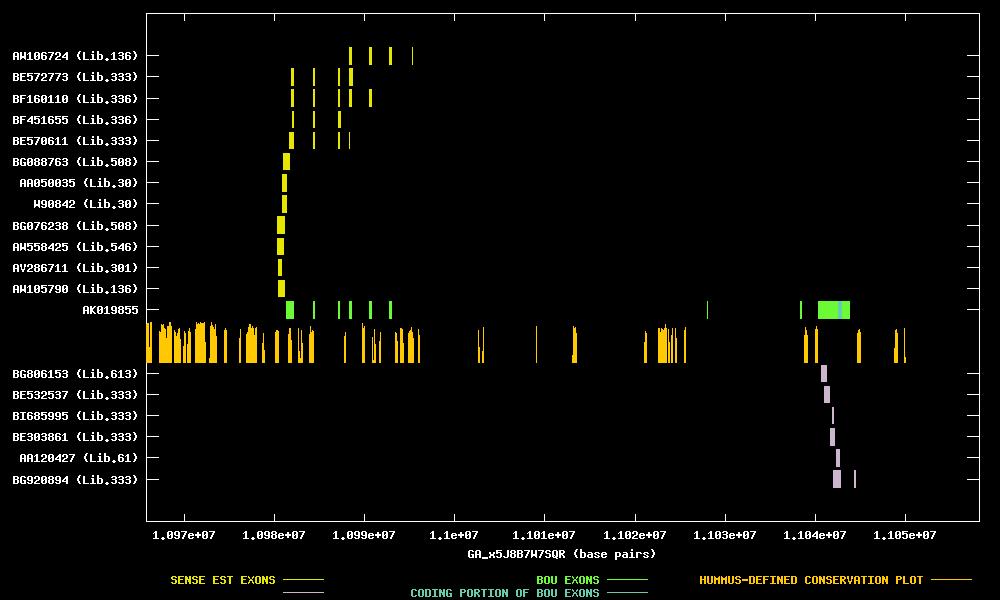
| Candidate UniGene cluster: | UniGene Cluster Mm.32800 |
| Description: | RIKEN cDNA 4932411A20 gene |
| Best-Of-UniGene (BOU) Sequence | AK019855 |
| Genomic Coordiantes Displayed: | Bases 10965800 to 11058200 of contig GA_x5J8B7W7SQR |
| BOU Orientation Along Contig: | RIGHT-TO-LEFT with respect to contig |
| Link to JPEG of genomic mapping | Mm.32800.jpeg |
| Best sense EST/protein match: | AK019855 matched dbj|BAB71035.1| (AK055884) unnamed protein product [Homo sapiens] (E = e-110) |
| Best antisense EST/protein match: | BG920894 matched dbj|BAB71617.1| (AK057940) unnamed protein product [Homo sapiens] (E = 2e-38) |

ANTISENSE ESTs
| BG806153 | cDNA clone (no-name) | neural retina | ||||
| BE532537 | cDNA clone IMAGE:3597749 | infiltrating ductal carcinoma | 5' read | |||
| BI685995 | cDNA clone IMAGE:5344396 | infiltrating ductal carcinoma | 5' read |  | ||
| BE303861 | cDNA clone IMAGE:3499552 | infiltrating ductal carcinoma | 5' read | |||
| AA120427 | cDNA clone IMAGE:537403 | embryo | 5' read | |||
| BG920894 | cDNA clone IMAGE:4953838 | infiltrating ductal carcinoma | 5' read |
| AW105790 | cDNA clone IMAGE:2236294 | kidney | 3' read |  | ||
| AV286711 | cDNA clone 5031426I22 | ovary and uterus | ||||
| AW558425 | cDNA clone L0296C02 | 3' read |  | |||
| BG076238 | cDNA clone H3157C07 | 3' read |  | |||
| W90842 | cDNA clone IMAGE:420456 | embryo | 5' read | |||
| AA050035 | cDNA clone IMAGE:478509 | embryo | 5' read | |||
| BG088763 | cDNA clone H3157C07 | 5' read | ||||
| BE570611 | cDNA clone IMAGE:3707691 | infiltrating ductal carcinoma | 5' read | |||
| BF451655 | cDNA clone IMAGE:3675110 | spontaneous tumor, metastatic to mammary. stem cell origin. | 5' read | |||
| BF160110 | cDNA clone IMAGE:3983955 | spontaneous tumor, metastatic to mammary. stem cell origin. | 5' read | |||
| BE572773 | cDNA clone IMAGE:3602111 | infiltrating ductal carcinoma | 5' read | |||
| AW106724 | cDNA clone IMAGE:2236294 | kidney | 5' read |  |